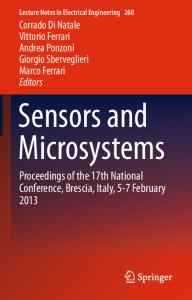Resonant Sensors for Microfluidic Applications
- PDF / 500,643 Bytes
- 6 Pages / 612 x 792 pts (letter) Page_size
- 60 Downloads / 400 Views
0951-E05-07
Resonant Sensors for Microfluidic Applications Florentina Niebelschütz, Katja Tonisch, Volker Cimalla, Klemens Brückner, Ralf Stephan, Matthias Hein, Andreas Schober, and Oliver Ambacher Institute of Micro- and Nanotechnologies, Technische Universität Ilmenau, Gustav-KirchhoffStr. 7, Ilmenau, 98693, Germany
ABSTRACT In this work we present both resonators working at ambient conditions and their first application as a biological and physical sensor. Singly- and doubly-clamped resonators of different geometries were realized using active layers of silicon carbide and aluminum nitride. The resonators were excited by magneto-motive actuation. The quality factor reached 350 and 50000 in air and in vacuum (2-5*10-5 mbar), respectively, which is sufficient for sensing applications in air. The resonance shift caused by mass loadings in the range of picograms and by single biological cells was measured at ambient conditions. Initial non-resonant measurements in liquids such as propanol were performed to investigate the possibility of viscosity measurements in small volumes such as microfluidic channels and droplets. INTRODUCTION Microfluidic applications often require an in situ control of environment properties such as viscosity, pressure and temperature. Such applications may even require the possibility to detect mass loadings caused by adhesion of biological molecules on functionalized surfaces. Combining mechanical structures with electrically active elements for actuation and sensing, the technology of micro- and nanoelectromechanical systems (MEMS/NEMS) holds a great potential for such sensing applications. In addition, possibilities for integration into microfluidic systems exist. The sensitivity of such sensors on additional mass loadings is increased by reducing the inherent active mass of the resonator, which is the reason for the ongoing work towards NEMS [1]. However, this low active mass reduces the ability to store energy within the system, resulting in a decrease of the quality factor and in complex response signals [2]. The high damping in most biological and chemical sensing applications which work under ambient conditions or even in liquids require a sufficient quality factor in vacuum [3]. Therefore, the design of a resonator for sensing applications at ambient conditions has to compromise the above mentioned contradicting requests. EXPERIMENT The active structures of these MEMS and NEMS were realized using silicon carbide (SiC) deposited by high vacuum chemical vapor deposition and polycrystalline aluminum nitride (AlN) grown by reactive sputtering on silicon substrates [4]. The top electrode necessary for magneto motive actuation consists of an evaporated titanium/gold layer system which is patterned by lift-off. Anisotropic dry etching of the active layer and isotropic dry etching of the silicon substrate lead to a free standing beam structure. The resonator design was based on free
standing singly- and doubly-clamped resonators with beam lengths of 10 to 500 µm and widths of 0.9 to 8 µ
Data Loading...









